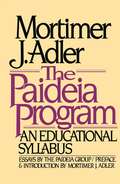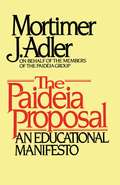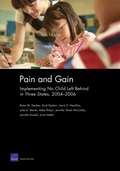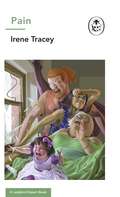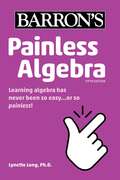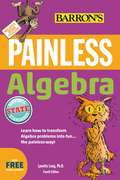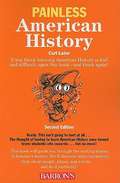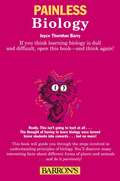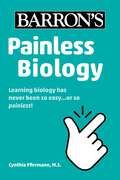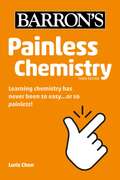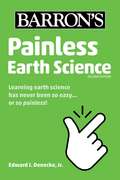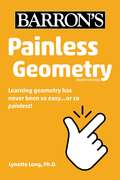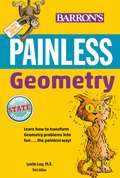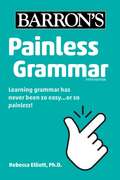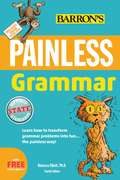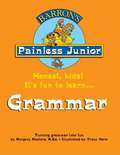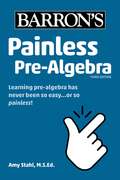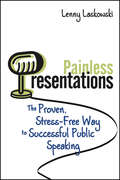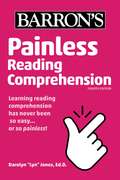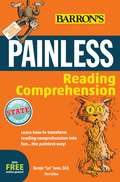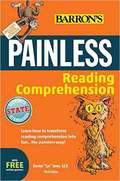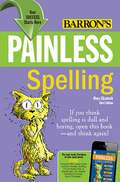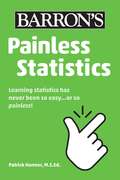- Table View
- List View
Pages of You
by Tricia SeaboltMelanie's grandfather has Alzheimer's disease. In one of his foggy moments, he decides to go grocery shopping and it proves to be an ordeal.
Paideia Program: An Educational Syllabus
by Mortimer J. AdlerPaideia is a holistic approach to life-long learning with roots in ancient Greece.The Paideia Program is based on the belief that the human species is defined by its capacity and desire for learning. The program itself argues for a public education that is at once more rigorous and more accessible.
Paideia Proposal
by Mortimer J. AdlerThe Paideia Proposal is a system of liberal education intended for all children. It was a response to what Adler characterized as the United States' antidemocratic or undemocratic educational system, a holdover from the 19th century, when the understanding of basic human rights fell short of 20th century expectations. The Paidea Proposal was based upon the following assumptions: 1) All children are educable; 2) Education is never completed in school or higher institutions of learning, but is a lifelong process of maturity for all citizens; 3) The primary cause of learning is the activity of the child's mind, which is not created by, but only assisted by the teacher; 4) Multiple types learning and teaching must be utilized in education, not just teacher lecturing, or telling; and 5) A student's preparation for earning a living is not the primary objective of schooling. Adler stressed that the proposal is much more than just a return to the basic skills of reading, writing and arithmetic. It is not simply a return to the values of classical civilization, but a return to what is of enduring value. It is a democratic proposal intended for the education of all, and not an elitist program as some have alleged.
Pain and Gain
by Brian M. Stecher Laura S. Hamilton Julie A. Marsh Scott Epstein Abby RobynThe Implementing Standards-Based Accountability (ISBA) study was designed to examine the strategies that states, districts, and schools are using to implement standards-based accountability under the No Child Left Behind Act (NCLB). This monograph presents information regarding the implementation of NCLB in California, Georgia, and Pennsylvania from 2003-2004 through 2005-2006, including the final results of the ISBA project.
Pain: A Ladybird Expert Book (The Ladybird Expert Series #39)
by Irene TraceyPART OF THE ALL-NEW LADYBIRD EXPERT SERIES- What is pain and can we measure it?- What is chronic pain and can we treat it?- Can we make pain pleasant?UNDERSTAND the causes and the reasons for pain. This complex, subjective but vital perception is experienced by the entire animal kingdom. We may not enjoy feeling it, but living without pain would be dangerous - it is our body's way of telling us when something isn't right.YOUR BODY'S BUILT IN ALARM SYSTEMWritten by Professor of Anaesthetic Neuroscience at the University of Oxford, Irene Tracey, PAIN is an accessible and fascinating illustrated introduction to one of our body's most important sensory and emotional experiences.
Painless Algebra (Barron's Painless)
by Lynette Long Ph.D.Barron's makes learning Algebra fun and PAINLESS!Painless Algebra provides lighthearted, step-by-step learning and includes:The many ways that Algebra can help you figure out practical problems in everyday lifePainless methods for understanding and graphing equations>Painless tips, common pitfalls, instructive tables, diagrams, &“brain tickler&” quizzes and answers throughout each chapter, and more.
Painless Algebra (Painless Series)
by Lynette LongDefines algebraic terms, shows how to avoid pitfalls in calculation, presents painless methods for understanding and graphing equations, and makes problem-solving fun. Titles in Barron's extensive Painless Series cover a wide range of subjects, as they are taught at middle school and high school levels. Perfect for supporting Common Core Standards, these books are written for students who find the subjects somewhat confusing, or just need a little extra help. Most of these books take a lighthearted, humorous approach to their subjects, and offer fun exercises including puzzles, games, and challenging "Brain Tickler" problems to solve. Bonus Online Component: includes additional games to challenge students, including Beat the Clock, a line match game, and a word scramble.
Painless American History (Painless Series) (2nd Edition)
by Curt LaderThe grand drama of American history is covered for middle school and high school students, starting with Columbus's landing, and continuing through European colonization, United States independence, and the nation's development and growth to become the leading world power. This edition has been updated to include important events of the twenty-first century. Titles in Barron's Painless Series are written especially for middle school and high school students who are having a difficult time with a specific subject. In many cases, a student is confused by the subject's complexity and details. Still other students simply finds a subject uninteresting, an attitude that usually results in lower grades. Painless titles offer informal, student-friendly approaches to each subject, emphasizing interesting details, supplementing the text with amusing insights, and outlining potential pitfalls clearly and step by step. Students begin to understand how disparate details all fit together to form a clear picture. Timelines, ideas for interesting projects, and "Brain Tickler" quizzes in many of these titles help to take the pain out of study and improve each student's grades.
Painless Biology
by Joyce BarryThis book (formerly titled Painless Life Science), proves that biology can be both intriguing and enjoyable. The author helps students solve puzzles and find answers to questions as they learn to classify living things from bacteria and viruses to plants and animals. Other topics covered include cells, parts of the plant, animals in their environments, human body systems, genetics, ecology, natural selection, and general health issues.
Painless Biology (Barron's Painless)
by Cynthia PfirrmannWhether you&’re a student or an adult looking to refresh your knowledge, Barron&’s Painless Biology provides review and practice in an easy, step-by-step format.An essential resource for:Virtual LearningHomeschoolLearning podsSupplementing classes/in-person learningInside you&’ll find:Comprehensive coverage of biology, including, nature of science, cell anatomy, biochemistry, animals and plants, genetics, and much more Diagrams, charts, and instructive science illustrations Painless tips, common pitfalls, and informative sidebars Brain Tickler quizzes and answers throughout each chapter to test your progress
Painless Chemistry (Barron's Painless)
by Loris ChenBarron's makes learning Chemistry fun and PAINLESS!Painless Chemistry provides lighthearted, step-by-step learning and includes:Complex topics broken down with examples and illustrations, including atomic theory, chemical bonding, the structure of molecules, and moreThe Periodic Table of Elements and how it offers the key to understanding ChemistryPainless tips, instructive tables,&“Brain Tickler&” quizzes and answers throughout each chapter, and more.
Painless Earth Science
by Edward J. Denecke Lynette LongTitles in Barron's extensive Painless Series cover a wide range of subjects as they are taught on middle school and high school levels. Perfect for supporting state standards, these books are written for students who find the subjects unusually difficult and confusing--or in many cases, just plain boring, and may need a little extra help. Barron's Painless Series authors' main goal is to clear up students' confusion and perk up their interest by emphasizing the intriguing and often exciting ways in which they can put each subject to practical use. Most of these books take a light-hearted approach to their subjects, often employing humor, and always presenting fun-learning exercises that include puzzles, games, and challenging "Brain Tickler" problems to solve. This title describes the exciting revolution in our understanding of Earth's processes and changes, focusing on movement of tectonic plates, earthquakes, volcanoes, and much more.
Painless Earth Science (Barron's Painless)
by Edward J. Denecke Jr.Learning at home is now the new normal. Need a quick and painless refresher? Barron&’s Painless books make learning easier while you balance home and school. Titles in Barron's extensive Painless Series cover a wide range of subjects as they are taught on middle school and high school levels. Perfect for supporting state standards, these books are written for students who find the subjects unusually difficult and confusing--or in many cases, just plain boring, and may need a little extra help.Barron's Painless Series authors' main goal is to clear up students' confusion and perk up their interest by emphasizing the intriguing and often exciting ways in which they can put each subject to practical use. Most of these books take a light-hearted approach to their subjects, often employing humor, and always presenting fun-learning exercises that include puzzles, games, and challenging "Brain Tickler" problems to solve. This title describes the exciting revolution in our understanding of Earth's processes and changes, focusing on movement of tectonic plates, earthquakes, volcanoes, and much more.
Painless Geometry (Barron's Painless)
by Lynette Long Ph.D.Barron's makes learning Geometry fun and PAINLESS!Painless Geometry provides lighthearted, step-by-step learning and includes:Characteristics of distinct shapes, such as circles, quadrilaterals, and trianglesDiscussion on how geometric principles can solve real-world problemsPainless tips, common pitfalls, instructive tables, diagrams, &“brain tickler&” quizzes and answers throughout each chapter, and more.
Painless Geometry (Painless Series)
by Lynette LongThe thought of solving theorems or postulates leaves some students quivering in their boots. . . but not anymore! <P><P>This must-have guide takes the pain out of learning geometry once and for all. The author demonstrates how solving geometric problems amounts to fitting parts together to solve interesting puzzles. <P><P>Students discover relationships that exist between parallel and perpendicular lines; analyze the characteristics of distinct shapes such as circles, quadrilaterals, and triangles; and learn how geometric principles can solve real-world problems. <P><P>Like all titles in Barron's Painless Series, this book presents informal, student-friendly approaches to learning geometry, emphasizing interesting details, outlining potential pitfalls step by step, offering "Brain Tickler" quizzes, and more.
Painless Grammar (Barron's Painless)
by Rebecca ElliottBarron&’s makes learning grammar fun and PAINLESS!Painless Grammar transforms dull, dry grammar rules into lighthearted, step-by-step learning and includes:Examples on constructing sentences the right way by using grammar rulesPainless tips, common pitfalls, sample sentences, and instructive tables and sidebars,&“Brain Tickler&” quizzes and answers throughout each chapter, and more.
Painless Grammar (Painless Series)
by Rebecca ElliottCombines instruction in sentence structure with examination of amusing expressions, and gives tips on email communication, editing a school paper, and more. Titles in Barron’s extensive Painless Series cover a wide range of subjects, as they are taught at middle school and high school levels. Perfect for supporting Common Core Standards, these books are written for students who find the subjects somewhat confusing, or just need a little extra help. Most of these books take a lighthearted, humorous approach to their subjects, and offer fun exercises including puzzles, games, and challenging “Brain Tickler” problems to solve. Bonus Online Component: includes additional games to challenge students, including Beat the Clock, a line match game, and a word scramble.
Painless Junior: Grammar
by Tracy Hohn Marciann Mcclarnon Donna Christina OliverioTeachers and students in third and fourth grades will value this instructive and entertaining journey to Grammar World, where kids have fun while they develop their facility in correct English usage. Grammar World is a make-believe amusement park where boys and girls are introduced in chapter one to the animals who teach them about different kinds of sentences: statements and questions, commands and exclamations, subjects and predicates, combining sentences, and how to avoid fragments and run-on sentences. Chapter two takes kids to Grammar World's rides, where they learn about nouns, pronouns, adjectives, and several other parts of speech. Chapter three takes them to the Water Park, where they learn how to use verbs. Chapter four is a dolphin show, and explanation of prepositions, prepositional phrases, conjunctions, and interjections. The fifth and final chapter is a fireworks display, in which kids learn punctuation, capitalization, abbreviations, and other details that will help them write clearly and correctly.
Painless Pre-Algebra (Barron's Painless)
by Amy Stahl M.S. Ed.Learning at home is now the new normal. Need a quick and painless refresher? Barron&’s Painless books make learning easier while you balance home and school. Teaches basic algebra, exponents and roots, equations and inequalities, and polynomials.Titles in Barron's extensive Painless Series cover a wide range of subjects, as they are taught at middle school and high school levels. Perfect for supporting Common Core Standards, these books are written for students who find the subjects somewhat confusing, or just need a little extra help. Most of these books take a lighthearted, humorous approach to their subjects, and offer fun exercises including puzzles, games, and challenging "Brain Tickler" problems to solve. Bonus Online Component: includes additional games to challenge students, including Beat the Clock, a line match game, and a word scramble.
Painless Presentations: The Proven, Stress-Free Way to Successful Public Speaking
by Lenny LaskowskiA simple road map to the world of professional presentations What happens when you're asked to give a speech, professionally or personally? If you get nervous, start sweating, and hope it's all just a bad dream then you aren't alone, but you need help. Painless Presentations proves that speaking doesn't have to be painful, or even stressful. A speech is a means to giving great, helpful material to an audience and the speaker is the vehicle to achieve that goal. This simple-to-read book guides those just beginning their journey into the world of speaking. Painless Presentations teaches the "Dozen Deadly Dangers" to avoid and much more. Explains how to gather information and materials Details the structure of a presentation Describes uses of visual aids and vocal variety Demonstrates how to handle questions Painless Presentations offers wisdom derived from Lenny Laskowski's thirty-five-year speaking career, delivering more than 2,700 programs to clients in over 178 countries. It will give you no-sweat tips for delivering speeches that win over your audiences every time and teaches you that giving speeches doesn't have to be painful.
Painless Reading Comprehension (Barron's Painless)
by Darolyn "Lyn" Jones Ed.D.Learning at home is now the new normal. Need a quick and painless refresher? Barron&’s Painless books make learning easier while you balance home and school. Reading comprehension gets easier as students learn what kind of reader they are, discover how to keep facts in their head, and much more.Titles in Barron&’s extensive Painless Series cover a wide range of subjects, as they are taught at middle school and high school levels. Perfect for supporting Common Core Standards, these books are written for students who find the subjects somewhat confusing, or just need a little extra help. Most of these books take a lighthearted, humorous approach to their subjects, and offer fun exercises including puzzles, games, and challenging &“Brain Tickler&” problems to solve. Bonus Online Component: includes additional games to challenge students, including Beat the Clock, a line match game, and a word scramble.
Painless Reading Comprehension (Painless Series)
by Darolyn "Lyn" Jones Ed.D.Reading comprehension gets easier as students learn what kind of reader they are, discover how to keep facts in their head, and much more. Titles in Barron’s extensive Painless Series cover a wide range of subjects, as they are taught at middle school and high school levels. Perfect for supporting Common Core Standards, these books are written for students who find the subjects somewhat confusing, or just need a little extra help. Most of these books take a lighthearted, humorous approach to their subjects, and offer fun exercises including puzzles, games, and challenging “Brain Tickler” problems to solve. Bonus Online Component: includes additional games to challenge students, including Beat the Clock, a line match game, and a word scramble.
Painless Reading Comprehension (Painless Series) Third Edition
by Darolyn Lyn" JonesReading comprehension gets easier as students learn what kind of reader they are, discover how to keep facts in their head, and much more. Titles in Barron's extensive Painless Series cover a wide range of subjects, as they are taught at middle school and high school levels. Perfect for supporting Common Core Standards, these books are written for students who find the subjects somewhat confusing, or just need a little extra help. Most of these books take a lighthearted, humorous approach to their subjects, and offer fun exercises including puzzles, games, and challenging "Brain Tickler" problems to solve. Bonus Online Component: includes additional games to challenge students, including Beat the Clock, a line match game, and a word scramble.
Painless Spelling (Painless Series)
by Mary Elizabeth M.Ed.A Simon & Schuster eBook. Simon & Schuster has a great book for every reader.
Painless Statistics (Barron's Painless)
by Patrick HonnerWhether you&’re a student or an adult looking to refresh your knowledge, Barron&’s Painless Statistics provides review and practice in an easy, step-by-step format.An essential resource for:Virtual learningHomeschoolLearning podsSupplementing classes/in-person learningInside you&’ll find:Clear examples for all topics, including data and distributions, basic probability, confidence intervals, bivariate statistics, and much moreDiagrams, charts, and instructive math illustrationsPainless tips, common pitfalls, and informative sidebarsMath talk boxes that translate complex &“math speak&” into easy-to-understand languageBrain Tickler quizzes throughout each chapter to test your progress

